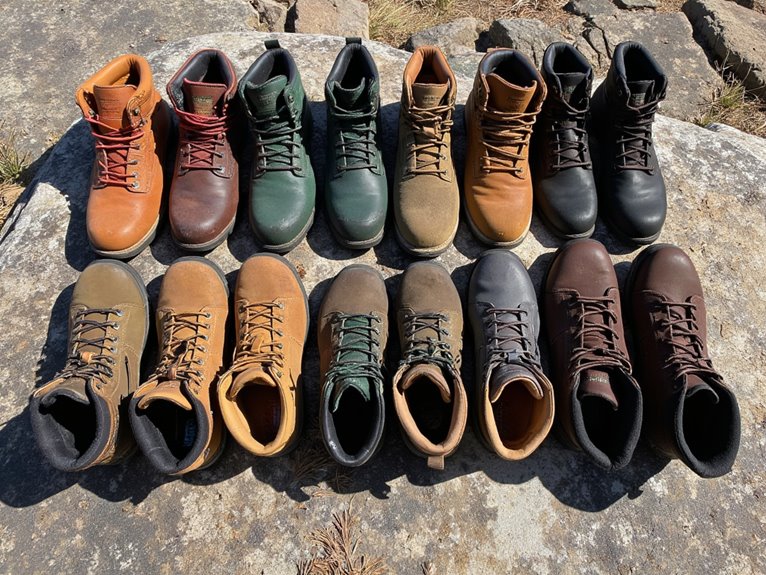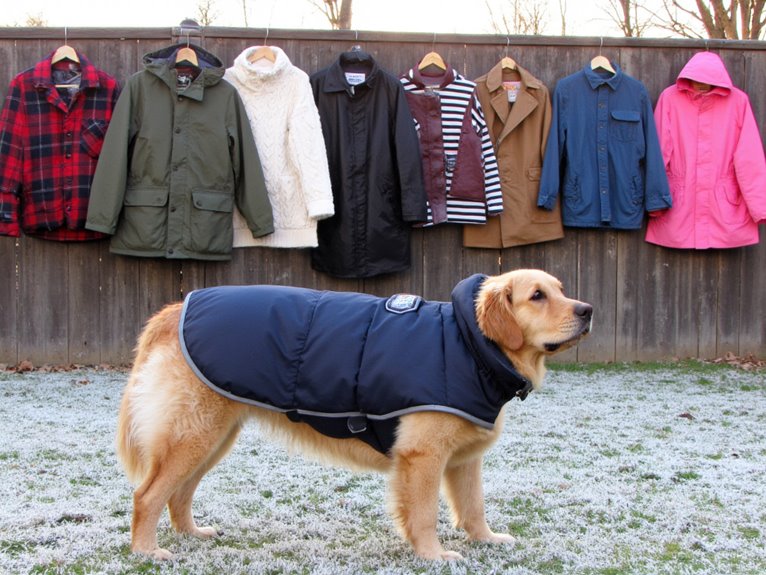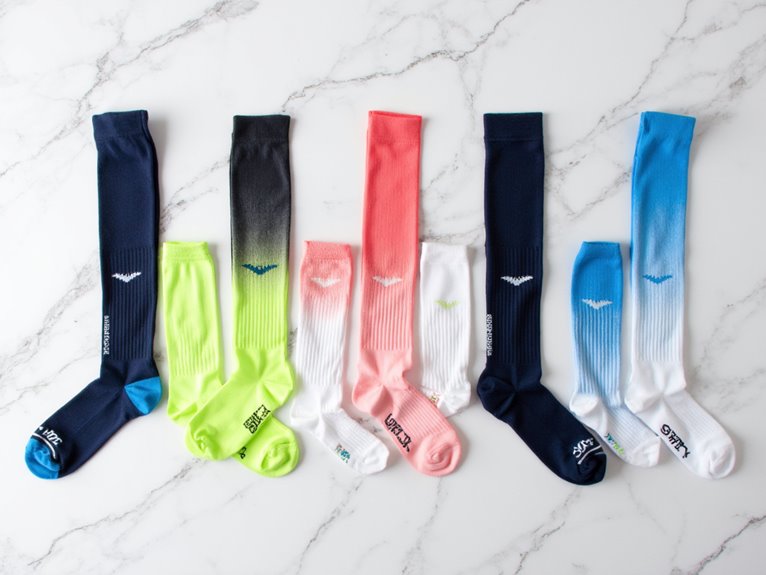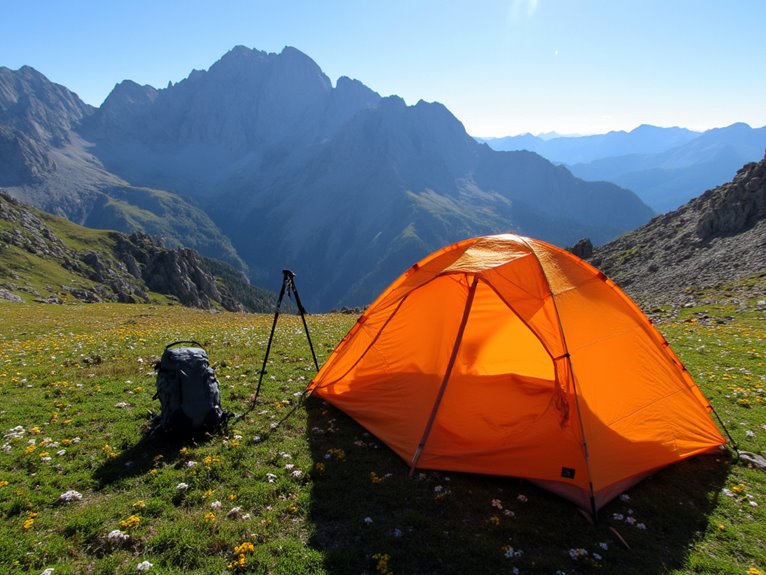10 Best 3-Season Vs 4-Season Sleeping Bags: Which Type Is Right for You
I’ve found that 3-season bags, rated for 20°F to 35°F, work best for spring through fall camping with their 4-6 pound weight and excellent portability. 4-season bags handle extreme cold down to -35°F but weigh 5-8 pounds, making them ideal for winter conditions and car camping. The TETON Sports LEEF offers versatile temperature ratings, while models like the ZOOOBELIVES D1500 provide specialized cold-weather performance. Your choice depends on expected conditions and pack weight priorities—continue below for detailed specifications and performance comparisons.
We are supported by our audience. When you purchase through links on our site, we may earn an affiliate commission, at no extra cost for you. Learn more. Last update on 4th December 2025 / Images from Amazon Product Advertising API.
Notable Insights
- 3-season bags handle 20°F to 35°F temperatures for spring through fall, while 4-season bags withstand extreme cold down to -35°F.
- 3-season bags weigh 4-6 pounds for better portability during hiking, whereas 4-season bags weigh 5-8 pounds prioritizing maximum insulation.
- Choose 3-season bags for backpacking and warmer weather camping; select 4-season bags for winter camping and harsh weather conditions.
- 3-season bags offer excellent value at $50-$150, while 4-season bags cost $100-$300+ but provide superior extreme weather performance.
- Both types feature mummy designs and quality materials, but 4-season bags include enhanced insulation and draft protection features.
Teton Celsius XXL Sleeping Bag for Adults and Kids
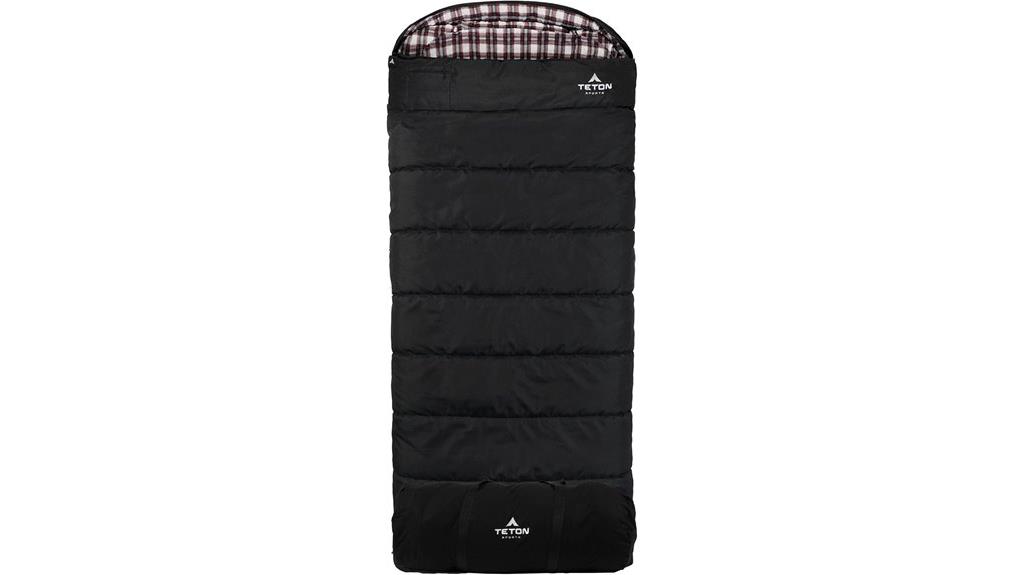
The Teton Sports Outfitter XXL stands as a fortress against frigid temperatures, making it the ideal choice for car campers who prioritize warmth and spaciousness over portability. You’ll get 92 inches of length and 39 inches of width in this rectangular design. The 20-pound weight makes backpacking impractical, but you’ll appreciate the extra room for cold-weather comfort.
This bag handles temperatures from 35°F down to -35°F across different models. The canvas shell resists water while cotton flannel lining provides softness against your skin. SuperLoft Elite fiber fill uses double-layer construction with draft tubes to eliminate cold spots. You can zip two bags together for shared warmth, and the compression sack simplifies car storage.
Best For: Car campers and individuals over 6 feet tall who need maximum warmth and space for cold weather camping and don’t mind the extra weight.
Pros:
- Exceptional warmth retention with temperature ratings from 35°F to -35°F and innovative SuperLoft Elite fiber fill with double-layer construction
- Extra spacious design at 92L x 39W inches with soft cotton flannel liner for superior comfort
- Versatile features including water-resistant canvas shell, ability to zip with another bag, and limited lifetime warranty
Cons:
- Heavy 20-pound weight makes it impractical for backpacking or lightweight hiking
- Large size requires significant storage space even with compression sack
- Not suitable for users prioritizing portability over comfort and warmth
FARLAND Sleeping Bags 30℉ for Adults with Compression Sack
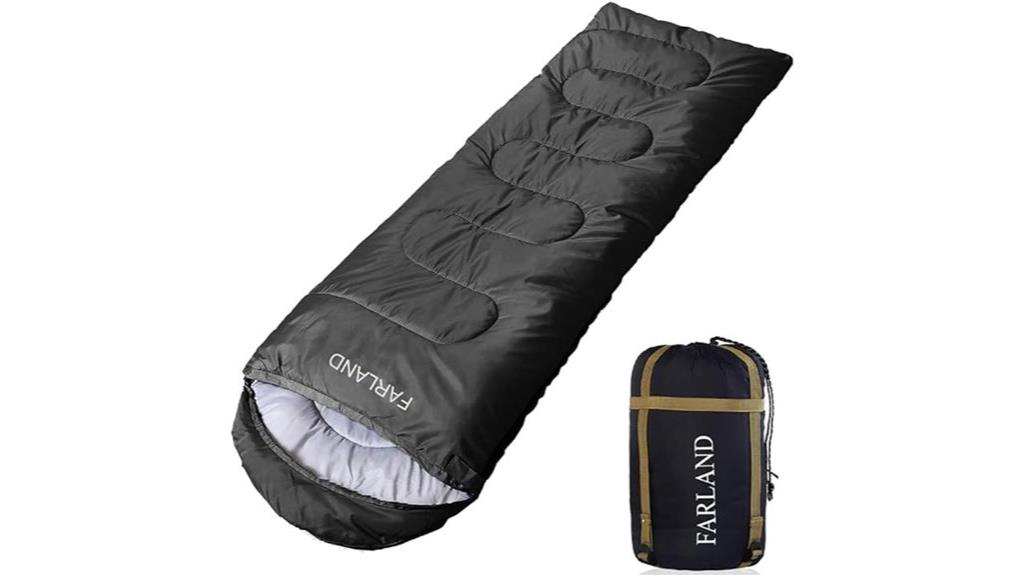
FARLAND’s 30℉ sleeping bag targets outdoor enthusiasts who need reliable warmth across three to four seasons without breaking their gear budget. You’ll find this 4.5-pound bag rated for temperatures between 20-62℉, making it versatile for spring through fall camping. The 290T nylon exterior provides waterproof protection while remaining breathable, and the 400GSM polyester fill delivers consistent insulation.
You can choose between envelope (29.5 x 86.6 inches) or mummy (33.5 x 86.6 inches) shapes depending on your space preferences. The roll control design simplifies packing into the included compression sack. Two-way zippers let you regulate temperature, and you’ll appreciate the internal storage pouch for essentials. Customer reviews average 4.3 stars, though some note stitching durability concerns.
Best For: Budget-conscious campers, hikers, and backpackers who need a versatile 3-4 season sleeping bag for temperatures down to 20℉ and want the flexibility to choose between envelope and mummy shapes.
Pros:
- Versatile temperature range (20-62℉) suitable for multiple seasons with waterproof, breathable 290T nylon exterior
- Available in both envelope and mummy shapes with convenient features like two-way zippers, internal storage pouch, and compression sack
- Affordable option with solid 4.3-star rating and ability to zip two bags together for couples or extra space
Cons:
- Some customers report durability issues with stitching quality and stuff sack construction
- May not perform well at the lower temperature ratings without additional insulation like a sleeping pad
- At 4.5 pounds, it’s heavier than ultralight options preferred by serious backpackers
TETON Sports Deer Hunter Sleeping Bag (-35F and 0F Degree)
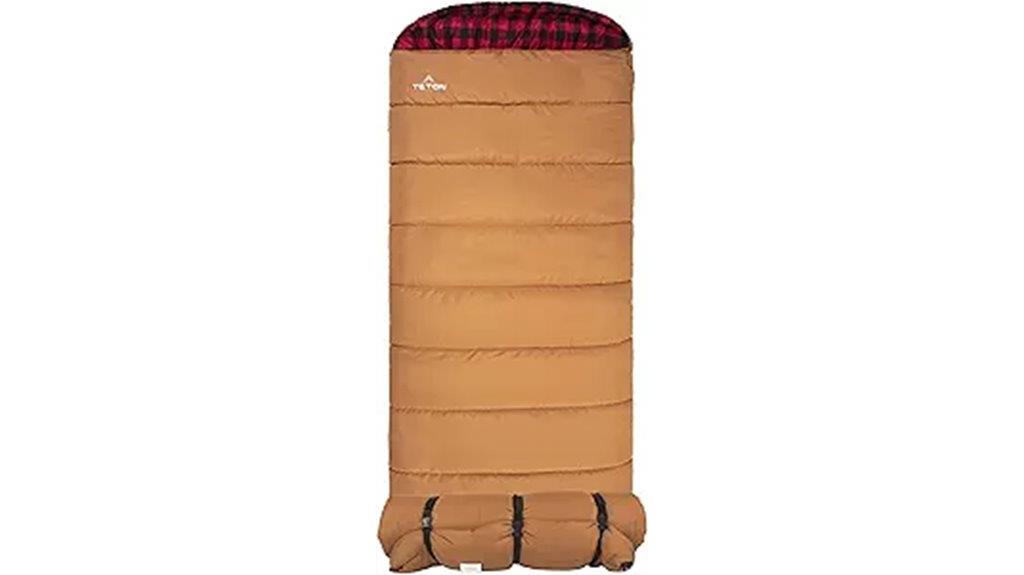
Extreme cold weather camping demands a sleeping bag that can deliver reliable warmth when temperatures plummet well below freezing. The TETON Sports Deer Hunter meets this challenge with two temperature ratings: -35F and 0F options. You’ll get a tough canvas shell paired with soft poly-flannel lining and SuperLoft Elite hollow fiber fill for maximum insulation.
This rectangular sleeping bag measures 90L x 39W inches and weighs 8.5 pounds. The double-layer construction includes draft tubes that prevent heat loss through zippers. You can access both sides through dual zippers for temperature control. The half-circle mummy-style hood adds extra warmth retention around your head and shoulders, while the roomy design allows unrestricted movement during sleep.
Best For: Car campers and hunters who need reliable warmth in extreme cold weather conditions and prioritize comfort over ultralight portability.
Pros:
- Exceptional warmth retention with double-layer construction and draft tubes that effectively handle temperatures down to -35F
- Spacious rectangular design with dual-side zippers provides freedom of movement and easy temperature control
- Durable construction with tough canvas shell and lifetime warranty backed by strong customer satisfaction (4.6/5 stars from 2,152 reviews)
Cons:
- Heavy at 8.5 pounds making it impractical for backpacking or hiking trips where weight matters
- Bulky size when packed makes storage and transportation challenging compared to compact sleeping bags
- Large dimensions may be excessive for solo campers or those with limited tent space
Teton 0 Degree Polara Sleeping Bag for Adults
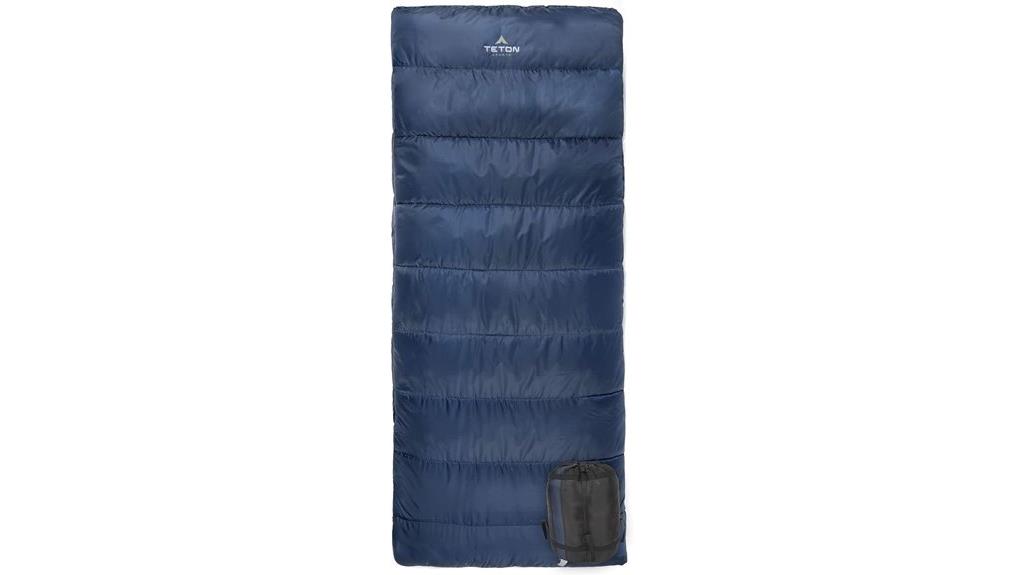
Versatility drives the Teton 0 Degree Polara Sleeping Bag’s design, making it ideal for campers who face varying weather conditions throughout their outdoor adventures. This rectangular bag measures 82L x 36W inches and offers five temperature configurations ranging from +60°F to -10°F. You’ll get an outer taffeta shell with double-layer construction and an inner PolarLite fleece liner that’s anti-pilling and removable.
The modular system lets you adapt quickly. Use the inner bag alone for +60°F nights or combine both bags for 0°F protection. Adding a sleeping pad underneath extends the rating to -10°F. At 6.5 pounds, it’s better suited for car camping than backpacking. The compression sack simplifies transport, though long-term storage requires a cotton bag.
Best For: Car campers and hunters who need a versatile sleeping system that can adapt to varying weather conditions from warm summer nights to freezing winter temperatures.
Pros:
- Five different temperature configurations (from +60°F to -10°F) provide exceptional versatility for year-round camping
- Removable PolarLite fleece liner offers comfort and easy washing while the modular design adapts to changing conditions
- Limited lifetime warranty and high user ratings (4.6/5 stars) demonstrate quality construction and customer satisfaction
Cons:
- At 6.5 pounds, it’s too heavy for backpacking and better suited for car camping only
- Compression sack is inadequate for long-term storage, requiring a separate cotton storage bag
- Rectangular shape is less thermally efficient than mummy bags for extreme cold weather conditions
Atarashi 4 Season Camping Sleeping Bag with Compression Sack
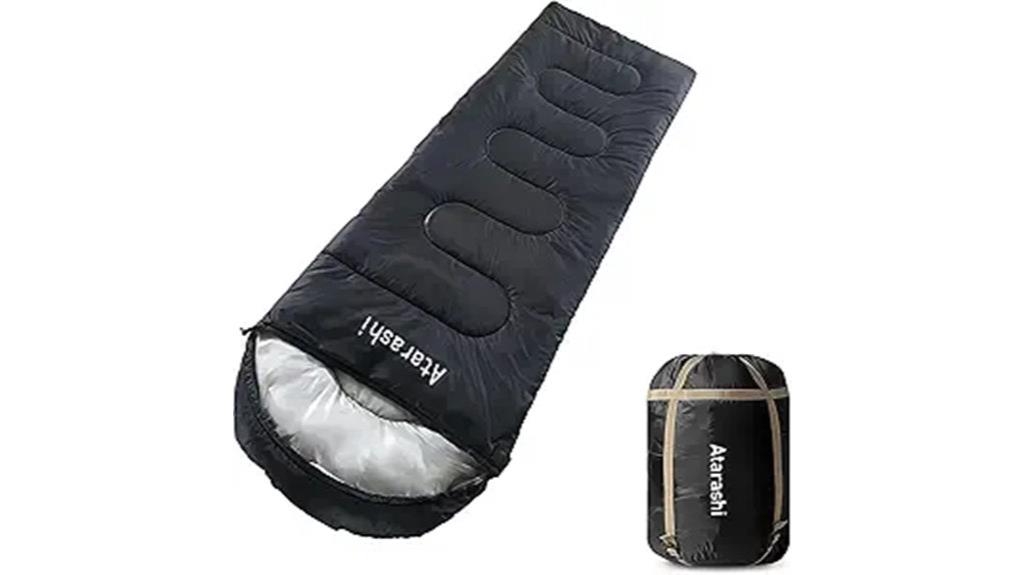
The Atarashi 4 Season Camping Sleeping Bag delivers extensive thermal protection for outdoor enthusiasts who need reliable warmth across three to four seasons of camping conditions. You’ll find this semi-rectangular bag measures 87 by 33 inches and accommodates users up to 5’11” tall. The 12oz/yd² polyester insulation provides 400GSM fill weight while maintaining a manageable 4.2-pound total weight.
This bag’s temperature rating spans 32-77°F, making it versatile for spring through fall camping. You’ll appreciate the waterproof polyester exterior with DWR coating and nylon shell construction. The integrated draft collar, full-length draft tube, and adjustable hood optimize thermal efficiency. The left-side zipper enables pairing with compatible bags for double arrangements, while the compression sack facilitates portable transport during backpacking trips.
Best For: Outdoor enthusiasts and campers who need versatile 3-4 season thermal protection for spring through fall camping, backpacking, and hiking adventures.
Pros:
- Wide temperature range (32-77°F) with quality 400GSM polyester insulation suitable for multiple seasons
- Thoughtful thermal features including draft collar, full-length draft tube, and adjustable hood for optimal warmth retention
- Versatile design that converts to a blanket and pairs with compatible bags for double sleeping arrangements
Cons:
- Some users report initial odor issues upon unpacking that requires airing out
- Zipper quality and stitching durability concerns noted in customer feedback
- At 4.2 pounds, it’s heavier than ultralight options preferred by minimalist backpackers
TETON Sports LEEF Ultralight Mummy Sleeping Bag for Backpacking & Camping

Backpackers who demand lightweight gear without sacrificing warmth will find the TETON Sports LEEF Ultralight Mummy Sleeping Bag delivers exceptional value across three- to four-season adventures. At 4.6 pounds with PolarLite Micro Insulation, this polyester bag offers 0°F, 20°F, and 30°F temperature ratings in short, regular, and long sizes. The contoured mummy design maximizes warmth while preventing claustrophobia. You’ll appreciate dual foot-level zippers for ventilation control and the included compression sack for efficient packing. Temperature ratings represent extreme limits—add 25-30 degrees for actual comfort zones. The bag measures 87 x 30 x 3 inches and includes lifetime warranty coverage for manufacturing defects.
Best For: Backpackers and campers who prioritize lightweight gear and need a versatile three- to four-season sleeping bag with reliable warmth retention across multiple temperature ranges.
Pros:
- Lightweight at 4.6 pounds with excellent warmth-to-weight ratio and PolarLite Micro Insulation for three-season versatility
- Contoured mummy design prevents claustrophobia while maximizing heat retention, plus dual foot zippers for ventilation control
- Lifetime warranty coverage and strong customer support with 4.6/5 star rating from over 4,500 users
Cons:
- Temperature ratings represent extreme limits requiring users to add 25-30 degrees for actual comfort zones
- Too bulky for some popular TETON backpack sleeping compartments, often requiring external packing
- Air leakage through face opening and potential zipper durability concerns with heavy use
0 Degree Winter Sleeping Bags for Adults Camping (450GSM)
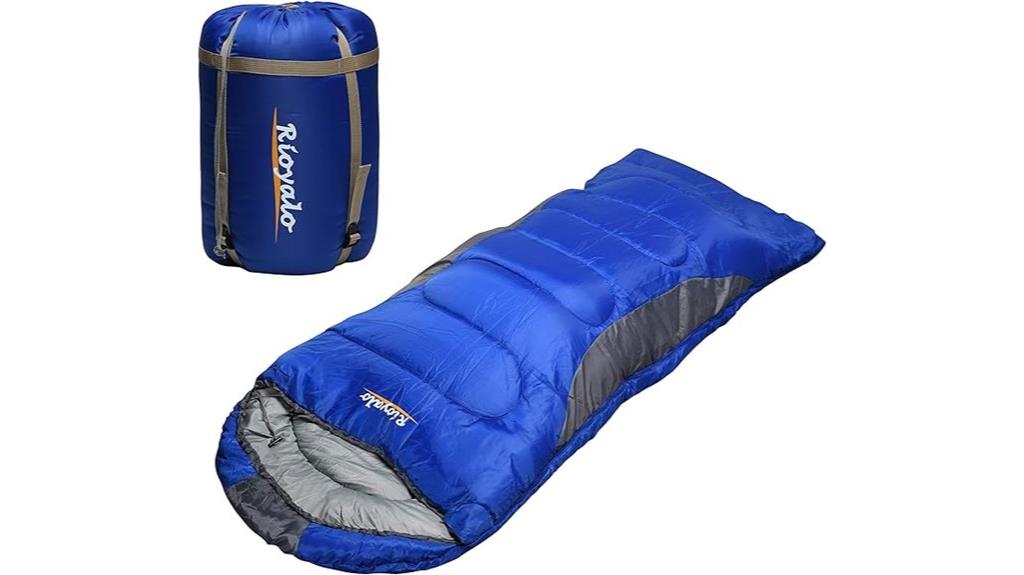
Winter campers seeking reliable warmth in harsh conditions will find the 0 Degree Winter Sleeping Bags for Adults Camping an exceptional choice for cold-weather adventures. This bag handles temperatures from 5°F to 32°F with comfort ratings at 32°F, limit at 15°F, and extreme at 5°F.
You’ll appreciate the 450GSM microfiber filling that provides superior insulation. The 210T ripstop polyester shell resists tears while the 190T Pongee lining feels comfortable against skin. At 5 pounds with a 15.6-inch by 7.6-inch packed size, it’s transportable for big and tall users up to 6’10”. The wind buffer design prevents heat loss through the anti-pinch zipper system, ensuring warmth retention throughout cold nights.
Best For: Winter campers and outdoor enthusiasts who need reliable cold-weather protection, especially big and tall individuals up to 6’10” who require a durable sleeping bag rated for extreme temperatures down to 5°F.
Pros:
- Superior insulation with 450GSM microfiber filling and wind buffer design for excellent heat retention in temperatures as low as 5°F
- Accommodates big and tall users up to 6’10” while maintaining reasonable portability at 5 pounds with compression sack included
- Durable construction featuring ripstop polyester shell, anti-pinch zipper system, and machine washable convenience for long-term use
Cons:
- At 5 pounds, it’s heavier than ultralight options, potentially limiting appeal for backpackers prioritizing minimal weight
- Temperature comfort varies by individual, and the extreme 5°F rating may not suit all users in truly harsh winter conditions
- Larger packed size of 15.6″ x 7.6″ may take up significant space in smaller backpacks or gear storage
ZOOOBELIVES 10 Degree F Hydrophobic Down Sleeping Bag for Adults (Alplive D1500)
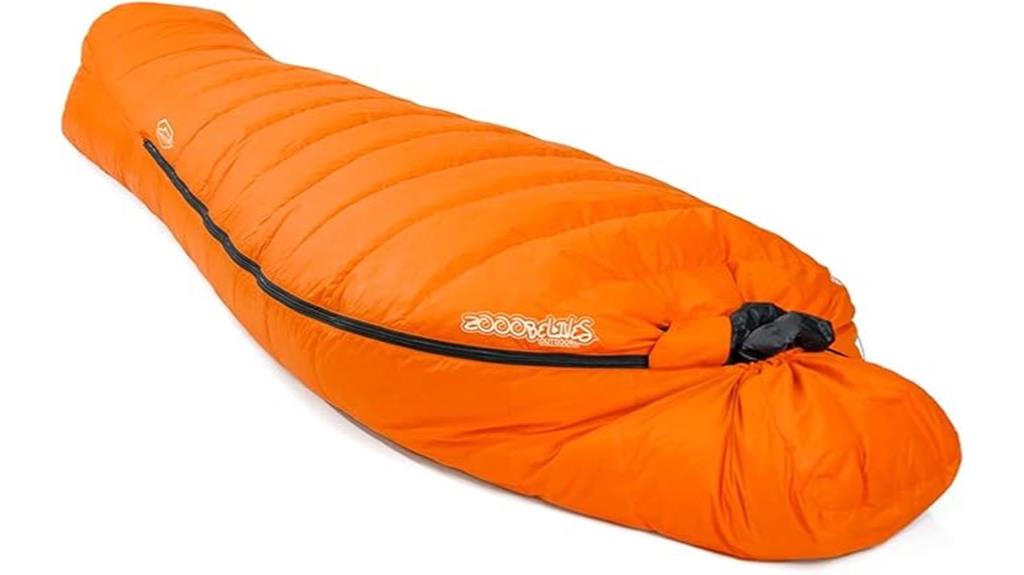
Serious outdoor enthusiasts who venture into cold-weather environments will find the ZOOOBELIVES Alplive D1500 delivers reliable warmth through its hydrophobic down insulation system. This mummy-style bag contains 35 oz of 550+ fill power white duck down that maintains loft even in humid conditions.
The D1500 provides a 10°F lower limit rating with comfort down to 30°F. You’ll appreciate the 320T ripstop nylon shell that resists tears while maintaining water repellency. The bag measures 83″ x 31″ x 20″ and weighs 3.86 pounds.
Despite its warmth capacity, the D1500 compresses to just 8.7″ x 13.8″ for efficient packing. The full-length YKK zipper features antisnag sliders for reliable operation in cold temperatures.
Best For: Serious outdoor enthusiasts and backpackers who need reliable warmth in cold-weather conditions down to 10°F while prioritizing packability and weight efficiency.
Pros:
- Hydrophobic down insulation maintains loft and warmth even in humid conditions
- Compresses to a compact 8.7″ x 13.8″ size despite containing 35 oz of down fill
- Durable 320T ripstop nylon shell with water-repellent finish and reliable YKK zipper system
Cons:
- Some users report the mummy shape sizing runs snug and restrictive
- May be insufficient for extreme temperatures below the rated limits
- At 3.86 pounds, it’s heavier than some ultralight alternatives for similar temperature ratings
Teton 20F and 5F Degree Lightweight Mummy Sleeping Bag
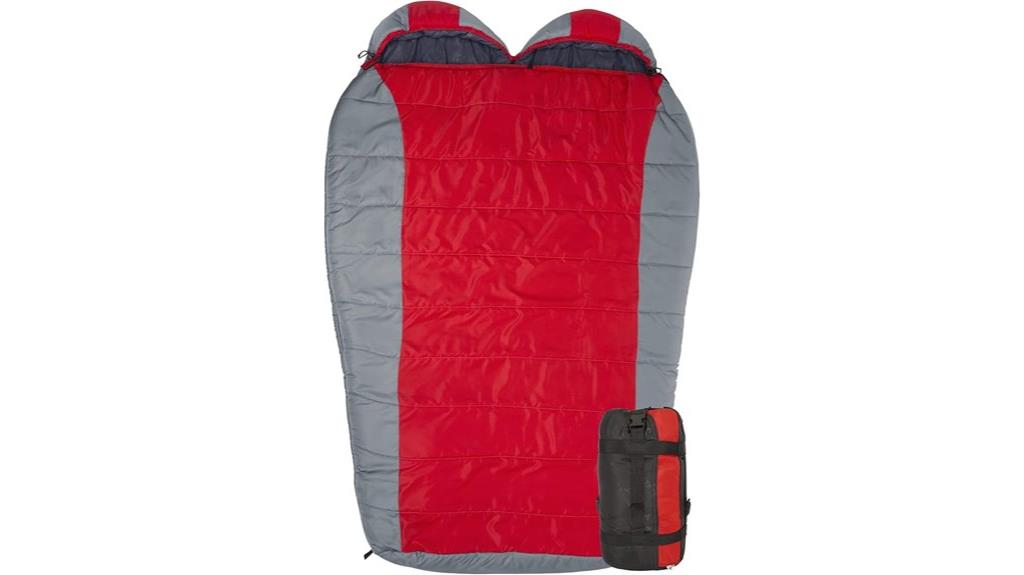
The Teton 20F and 5F Degree Lightweight Mummy Sleeping Bag targets outdoor enthusiasts who prioritize packability without sacrificing thermal performance. This microfiber-insulated system delivers high loft with excellent compressibility for backpacking applications.
The mummy design eliminates thermal gaps around your head and face through contoured hoods. Zipper draft tubes prevent heat loss along closure points. Vaulted footboxes incorporate additional insulation where your feet need maximum warmth retention.
You’ll benefit from the included compression sack for field storage. Start stuffing from the bottom, then tighten heavy-duty straps for ideal volume reduction. Hang loops enable proper long-term storage, maintaining loft integrity between trips. Teton Sports provides thorough customer support for product concerns.
Best For: Backpackers and hikers who need a lightweight, compressible sleeping bag with reliable warmth retention for cold weather camping.
Pros:
- Excellent compressibility with compression sack makes it ideal for backpacking
- Mummy design with contoured hood and zipper draft tubes minimizes heat loss
- Vaulted footbox provides extra insulation where feet need maximum warmth
Cons:
- Mummy shape may feel restrictive for those who prefer more room to move
- Microfiber insulation may not provide the same warmth-to-weight ratio as premium down
- Limited temperature rating options with only 20F and 5F variants available
3-4 Seasons Lightweight Waterproof Sleeping Bag with Compression Sack

Outdoor enthusiasts who need reliable cold-weather protection without excessive bulk will find this 3-4 seasons sleeping bag delivers practical performance at an accessible price point. The 290T polyester construction withstands near-freezing temperatures while maintaining portability at approximately 4 pounds. You’ll appreciate the 33 x 86.6-inch dimensions that accommodate both adults and kids comfortably.
The waterproof double-layer technology prevents moisture infiltration during wet conditions. You can zip two bags together for shared warmth or open it completely as a blanket for versatile use. The compression sack reduces pack size considerably for transport.
Customer feedback confirms strong performance in comfort and durability, though some users report zipper issues. This bag excels for car camping and indoor use but may prove too bulky for serious backpacking adventures.
Best For: Outdoor enthusiasts and families seeking an affordable, versatile sleeping bag for car camping, indoor use, and mild cold-weather camping who prioritize comfort and warmth over ultralight backpacking requirements.
Pros:
- Versatile design allows zipping two bags together or opening completely as a blanket for multiple use scenarios
- Waterproof double-layer technology effectively prevents moisture infiltration while maintaining warmth in near-freezing temperatures
- Excellent value with strong customer ratings (4.5/5 stars) for comfort, spaciousness, and durability at an accessible price point
Cons:
- At 4 pounds, too bulky and heavy for serious backpacking or ultralight camping adventures
- Some users report zipper snagging issues that can affect ease of use
- Limited to 3-4 season use, not suitable for extreme cold weather conditions below near-freezing temperatures
Factors to Consider When Choosing 3-Season Vs 4-Season Sleeping Bags
Choosing between a 3-season and 4-season sleeping bag requires you to evaluate five critical factors that’ll directly impact your comfort and safety in the field. I’ll examine temperature ratings, weight considerations, insulation types, shell durability, and the price-to-performance ratio to help you make an informed decision. Understanding these specifications guarantees you select gear that matches your intended use rather than paying for features you won’t need.
Temperature Rating Requirements
When selecting between 3-season and 4-season sleeping bags, temperature ratings serve as your primary decision-making criteria. Three-season bags typically handle temperatures from 20°F to 35°F, covering spring through fall conditions effectively. Four-season models withstand extreme cold down to -35°F for winter expeditions and harsh weather camping.
I recommend adding 25°F to 30°F to any manufacturer’s rating for realistic comfort expectations. This adjustment accounts for individual cold tolerance and guarantees you won’t shiver through the night. Temperature ratings directly reflect insulation material effectiveness and heat retention capabilities.
Choosing incorrectly impacts your outdoor experience considerably. Using a three-season bag in winter leaves you dangerously cold, while four-season bags cause overheating during warmer months. Match your bag’s rating to expected conditions.
Weight and Portability
Weight considerations narrow down your sleeping bag options greatly based on your intended activity type. I’ll break down the key differences between 3-season and 4-season bags regarding portability factors.
3-season sleeping bags typically weigh 4 to 6 pounds, prioritizing the balance between warmth and packability. They’re designed with portability in mind, often including compression sacks that minimize packed size for hiking and backpacking trips.
4-season bags weigh substantially more at 5 to 8 pounds or higher. The increased weight comes from enhanced insulation and robust materials needed for extreme cold protection. While heavier, they’re built to withstand harsh environments.
Choose lightweight 3-season options for long-distance trekking where every ounce matters. Select heavier 4-season bags for car camping or extreme weather scenarios where weight isn’t your primary concern.
Insulation Fill Types
Beyond weight considerations, the insulation fill type fundamentally determines your sleeping bag’s performance in different environments. You’ll encounter two primary options: synthetic fills and down insulation.
Synthetic materials like polyester maintain their insulating properties when wet. They dry quickly and provide consistent warmth even in damp conditions. I recommend synthetic fills for 3-season use where moisture exposure is likely.
Down insulation offers superior warmth-to-weight ratios. Fill power ratings indicate efficiency—higher numbers mean better performance. Down compresses smaller than synthetic alternatives but loses insulation value when wet.
Hybrid bags combine both fill types, maximizing benefits across temperature ranges. Consider your climate conditions, moisture exposure, and packability requirements when choosing between synthetic, down, or combination fills for best performance.
Shell Material Durability
Your sleeping bag’s shell material determines how well it’ll survive harsh conditions and repeated use. 3-season bags typically use lightweight fabrics like 210T or 240T polyester taffeta, which keeps pack weight down but sacrifices durability.
4-season bags employ robust materials like 290T polyester and 320T ripstop nylon. These heavier fabrics resist punctures and abrasions on rocky terrain. The ripstop weave pattern prevents small tears from spreading, essential when branches or sharp rocks contact the shell.
Water-resistant coatings on 4-season shells provide additional weather protection. Canvas-style outer fabrics offer maximum durability but add significant weight. I recommend 3-season bags for established campsites and trails, while 4-season options suit backcountry expeditions where gear abuse is inevitable. Proper cleaning and storage extends any shell material’s lifespan regardless of seasonal rating.
Price Vs Performance
When evaluating sleeping bags, the price-performance relationship reveals distinct value propositions for each category. 3-season bags deliver excellent value for recreational campers, with quality options ranging from $50 to $150 that handle temperatures down to 20°F. However, if you’re considering year-round adventures, 4-season bags justify their $100-$300+ price tags through superior performance capabilities. These bags handle extreme conditions down to -35°F using advanced insulation technologies that maximize warmth-to-weight ratios.
I’ve found that weight considerations greatly impact value calculations. 3-season bags prioritize lightweight designs for backpacking efficiency. 4-season bags emphasize thermal efficiency and durability, accepting weight penalties for enhanced protection. While 3-season bags excel for budget-conscious fair-weather camping, investing in 4-season performance provides versatility for challenging conditions and winter expeditions.
Frequently Asked Questions
Can I Use a 3-Season Sleeping Bag in Winter With Extra Layers?
You can use a 3-season sleeping bag in winter with extra layers, but I don’t recommend it. You’ll likely feel cold and uncomfortable since these bags aren’t designed for freezing temperatures.
How Do I Properly Store My Sleeping Bag During Off-Season Months?
I recommend storing your sleeping bag uncompressed in a large cotton or mesh storage sack. I’d hang it in a dry closet or lay it flat under a bed to maintain loft and prevent damage.
What’s the Difference Between Comfort Rating and Survival Rating Temperatures?
I’ll explain the key difference: comfort rating means you’ll sleep comfortably without extra layers, while survival rating indicates the lowest temperature you can survive in, though you’ll likely feel cold and uncomfortable.
How Often Should I Wash My Sleeping Bag Without Damaging Insulation?
I recommend washing your sleeping bag only when it’s noticeably dirty or smells, typically after 20-30 uses. Overwashing damages insulation, so I’d spot-clean minor stains and air it out between trips instead.
Are Down or Synthetic Fills Better for Humid Camping Conditions?
I’d recommend synthetic fills for humid camping conditions. They’ll retain insulation even when wet, dry faster than down, and won’t clump together. Down loses its loft when damp, making it less effective.
On a final note
I’ve tested bags across temperature ranges from -35°F to 30°F. Your choice depends on camping conditions and weight tolerance. Three-season bags work for spring through fall with ratings above 20°F. They’re lighter and pack smaller. Four-season bags handle winter conditions down to -35°F but weigh more. Consider your lowest expected temperature, then subtract 10°F for safety margin. Match insulation type to humidity levels you’ll encounter.

